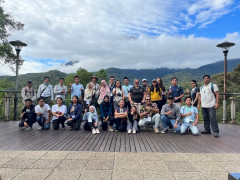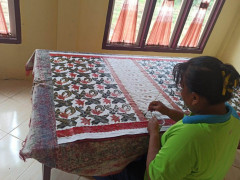Woman Fighting Oppression: Sumarni Laman
By Pantau GambutThe Journey of Peat in Teluk Meranti

In the past, the people of Teluk Meranti cleared the surrounding peatlands through an intricate series of rituals before planting rice. The optimal timing to clear peatland was determined by observing the wind direction. Today, government regulations banning the burning of peatland have caused a decline in the community’s income.
Teluk Meranti Village lies along the Kampar riverbanks, whose conditions are impacted by tidal water from the Kampar river. This area is roughly 135 km away from the capital of the Pelalawan district. Previously, this area could only be reached by water transportation routes such as speed boats, ships, and motor boats from Pangkalan Kerinci. Fortunately, it can now be accessed by road.
This area has extensive natural potential, which can be used to sustain the local community. One of these opportunities is tourism. If developed, tourism could improve local living standards and economies, and increase the income of the whole Pelalawan district. Developing existing tourism sites would create job opportunities, by bringing new developers and other home industry-based business opportunities to the area.
There are also cultural activities that have the potential to attract tourists to the area. These include silat (traditional martial arts), dances, traditional folk games, and many others. For a spiritual tourism, the area is also home to the tomb of a local hero, who was given a title ‘Datuk Serapung’.
The Local Wisdom of Teluk Meranti Community
Around 1920, there was a community group in Osam Kampong or Pangkalan Panduk that still believed in the powers of a kemantan (shaman). Three well-known shamans were called Kemantan Panjang, Kemantan Gogak, and Kemantan Peso. These three shamans were siblings who competed against each other everyday for the highest supernatural power.
At the same time, a number of fatal tiger attacks caused the community to feel threatened and begin plans to move to Batu Pahat, Malaysia. However, on their way down the Kampar river in their boat, the community noticed that the areas around the Serkap, Pebilah, Turip, and Sangar rivers had great farming potential. So, the kemantan decided to stop and built houses and farmland. After six months cultivating the land, the villagers saw great results in the rice harvest, when planted in peatland 3–20 deep. Thus, they decided to stay for good.
This farming community has a local custom related to peatland utilization. In the past, the community determined the best time to clear the peatland based on the wind direction and when it would be safe for farming. Prior to clearing the forest for farmland, it was necessary to consult with a bomo (a shaman specializing in farmlands) named Mangkayo Kopa to confirm which forest could be converted. At that time, villagers believed farmland pests were not animals, but ghostly creatures living in the forest. The villagers clearing the forest had to bring incense, white cloth, yellow cloth, black cloth, purple cloth, red cloth, horse manure, and rust to show that the land had been claimed. The bomo would also cast a spell to get rid of the ghostly creatures, so they would not disturb the land. The villagers mostly planted and cultivated rice fields in five lanes covering less than two hectares. A jombo covered 10x10 depa or 16 m x 16 m; a lane consisted of 10 jombos; and 36 jombos equaled one hectare.
The optimal timing to clear peatland was determined by observing the wind direction. The northern wind in the first month (January) indicated the perfect timing for the community to raze the forest (tobe tobang). Afterwards, the land was left idle for three months so the cut-down traces could dry. Then, when the southern wind arrived (around May or June), the land was burned with incense for three consecutive days. After the fire and smog disappeared, rice sowing could begin.
Aceh rice, sticky rice, jambai, cokuh, and all swamp rice varieties could be planted in peatlands. After sowing the rice, cloths of various colours would be laid down on the land for six months as a sign to repel pest. During the planting period, the villagers would go fishing, and the fish they caught would be distributed among community members, not sold. During this time, the rice fields were left alone, and they were not damaged or disturbed by pests at all.
Coming into the sixth month (July), the harvest began. Half of the rice harvest would be stored in a space adjacent to their houses, known as mangkiang or rangkiang. The rest of the rice was dried under the sun and separated from the husks. The rice would then be cooked for a feast, and the bomo would lead a prayer for safety as a “debt-paying” ritual. The bomo was paid with a bushel of harvested rice in a coconut shell container. Finally, a great harvest would conducted for one month, resulting in approximately 300 bushels of rice from five lanes.
In 1960, the villagers started to clear the peatland for a rubber plantation, to be planted with rubber tree seeds found on beaches and the Serkap riverbanks. Initially, the forest clearance for rubber plantations started from Teluk Tanah Tebakar to Tanjung Lombing. Once the trees were eight years old, the latex could be tapped and the bushes chopped down. The ritual of initiating a rubber plantation was similar to the one for initiating new farmland, minus the debt-paying ritual to the bomo.
The latex from the rubber trees was tapped and processed everyday. One hectare of peatland planted with rubber trees produced five kg of rubber, which was sold for one rupiah per kilogram at that time. The rubber plantation’s produce was collected for one month, then sold to villagers in Tanjung Batu. In addition to rubber, the community cultivated vegetables and made their own cooking oil from the fruit of the Suntai tree to meet their needs.
For the Teluk Meranti community, humans and nature have an interdependent relationship. When nature is destroyed, the community’s socioeconomic conditions are also damaged.
In the past, nature was not destroyed, because the community still highly valued local customs and culture. They adhered to the prohibition against burning down the forests and cutting down Batang Sialang trees (a tall tree where bees often build their nests and produce honey). They did not whistle or say inappropriate words while farming. That was the common law that applied in the past. The local tradition of building ditches before clearing forest land for farming aimed to create a flow in the stagnant water, so the fire would not spread. The village ritual of gawe-gawe was held annually, just before clearing the peatland for farming. In these rituals, indigenous institutions are present to uphold local customs related to land clearance.
Today, many regulations are broken, which contributes to accelerating climate change. People can no longer predict the optimal timing to begin farming. Natural disasters such as floods and landslides occur frequently, because there is nothing to hold the soil during heavy rains. Pests and wild animals appear in residential areas, because human activity has cut down and damaged their habitat. Customary practices of sustainable land/forest clearance are no longer implemented, making it easier for fire to spread. Common law is no longer effective, as it has been replaced with government regulations.
Unfortunately, government regulations that contradict local wisdom in Teluk Meranti have caused a decline in the community’s income. Previously, corn farmers who burned the peatland could produce 5–7 tons of maize on two hectares of land. However, since the government banned peatland burning, the farmers can only harvest 180 kg of corn on the same two hectares of land.
In addition to economic changes, the Teluk Meranti community is also experiencing rapid social change. High unemployment due to dormant lands has resulted in high crime rates in the village. The community has protested to both the government and law enforcement institutions, but they have not responded with a solution to help the community manage the peatland without burning it or find an alternative income source. Now, palm oil has become the primary commodity in Teluk Meranti, because they have realized that palm oil is easier to plant and provides neighboring communities a better income. They previously relied on corn, but now must adapt to the government regulation banning the peatland burning.
The government of Teluk Meranti is now cooperating with a company to clear 20 hectares of the village peatland without burning. This project began in June 2016 by clearing the land with heavy equipment, insecticides, and fertilizer in order to plant rice. However, the results were unsatisfactory.
In an effort to mitigate forest and peatland fires, PT RAPP took the initiative to conduct socialization trainings with local communities. PT Arara holds an Integrated Patrol Program for three months during dry seasons. This program aims to monitor, detect, and extinguish hotspots (locations with high fire breakout risk) with the support of five local people. In 2016, the Ministry of Environment and Forestry conducted patrol and socialization activities through a collaboration with Manggala Agni (a forest firefighting brigade), Babinsa (Indonesian army troops stationed in local villages), the National Police, and two local people.
These programs held have helped to increase the community’s awareness of the dangers of forest and peatland fires, and raise concerns about clearing peatland by burning it. Nevertheless, the people of Teluk Meranti hope for a solution that would allow people to use peatlands productively without burning them.



